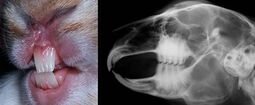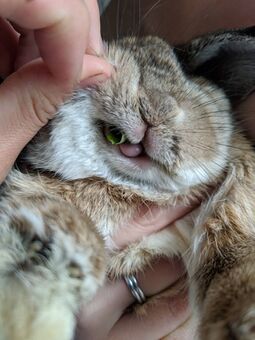Teeth
Rabbits are lagomorphs with 28 teeth and 4 upper incisors - two peg teeth are located behind the first set of primary upper incisors. Lagomorph teeth are open rooted (elodont) and grow continuously throughout their lifetime.
Are rabbits born with baby teeth?
Rabbits are born with baby (deciduous) teeth that are fully shed by around 35 days of age. The deciduous teeth erupt in utero and consist of far fewer teeth than in adult rabbits. At or around the time of birth, the first deciduous incisors are lost and by about day 35 the final deciduous molars are replaced by larger permanent teeth.[1]
| Incisors | Canines | Premolars | Molars | Total | |
|---|---|---|---|---|---|
| Deciduous | 2/1 | 0/0 | 3/2 | 0/0 | 16 |
| Permanent | 2/1 | 0/0 | 3/2 | 3/3 | 28 |
Extra resources
- S.L. Horowitz et al. (1973). Deciduous dentition in the rabbit (Oryctolagus cuniculus): A roentgenographic study
How fast do rabbit teeth grow?
The rate of growth is variable between individuals and influenced by age, pregnancy, and diet. Rabbits require a constant supply of calcium and other minerals and nutrients to support the formation of enamel and dentine.[2] Rabbit teeth grow at approximately 2 mm per week and require a constant supply of calcium.[3] One study recorded the growth of upper incisors at 2mm per week and lower incisors at 2.4mm per week.[2]
In healthy rabbits, their teeth are kept in shape by continual growth and the occlusal wear of tooth against tooth (attrition). Dental wear is affected by contact with food and the abrasive nature of their diet. Silicate phytoliths in the skeleton of grasses, cellulose, and lignin are all abrasive materials that can help with dental abrasion in rabbits.[2]
Dental problems
The exact cause of dental disease in rabbits is unclear, although it is likely to be multifactorial and involve the following:[4]
- Inadequate teeth wear due to insufficient coarse fiber in the diet.
- Nutritional deficiency, including calcium, vitamin D, vitamin A, magnesium and protein.
- Genetic disposition—Netherland Dwarfs and lop-eared rabbits with flat faces seem to be especially susceptible.
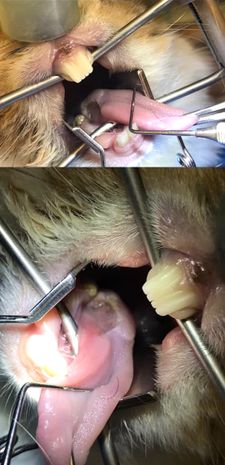
How can I help prevent dental disease in my rabbits?
Some tips include the following:[3]
- Ensure growing rabbits have sufficient calcium and vitamin D. Growing rabbits are most susceptible to metabolic bone disease. Calcium should be 0.5-1.0% of the diet to provide sufficient calcium for the mineralization of growing teeth and surrounding bone.
- Provide unlimited fibrous foods such as grass and hay. Hay should be of a good quality. Calcium in poor-quality hay can be as low as 0.25% which is lower than the 0.44% dietary requirement for bone mineralization.
- Feed at least 3 types of fruits or vegetables a day, including one type of fibrous vegetable such as broccoli, cabbage, spring greens, spinach or cauliflower leaves. Root vegetables and fruit, such as carrots and apples, are poor sources of calcium and should only be used as treats.
- Do not allow rabbits to select low calcium cereals legumes from muesli pellet mixtures. Palatable extruded or pelleted diets are preferable as they prevent selective feeding. High calcium supplements should be avoided due to the risk of urine sludging.[3]
Dental irritation
Sometimes rabbits may get food or objects stuck in their mouth or teeth, and it can cause alarming behavior with excessive lip-licking and head throwing as the rabbit tries to loosen and remove the stuck object. Rabbits should be taken to a rabbit-savvy veterinarian for a professional assessment if this behavior is persistent or re-occurring as it may be a sign of more serious dental issues.
The following are a few examples of this type of behavior:
- u/WickandFable. (2021). Behavior: (Medical) Dental Irritation - Excessive Lip-Licking
- u/DKMR. (2021). He throws his head back when eating some fruits like apples, the vet keeps telling me he's ok during checkups... Any experience with this behaviour?
Drooling
The medical term for drooling is ptyalism. Owners will often find perpetually wet spots around their rabbit's mouth and on their chin. When left wet long enough, the area may eventually lose fur and develop moist dermatitis.
Lop and dwarf breeds may be prone to having a long-lasting wet chin when drinking from a bowl or eating wet vegetables and not grooming themselves properly afterwards. Owners can help by manually wiping their chins with a towel and consider switching them to water bottles to prevent the issue from reoccurring.
Dental issue drooling should also not be confused with an over-reactive scent gland under the rabbit's chin. Some rabbits may be overenthusiastic with their claiming of territory and rub their chin to irritation.
See the links below for more information about drooling in rabbits.
- MediRabbit, Differential Diagnosis for Ptyalism
- MediRabbit, Esther van Praag, Ph.D., Excessive secretion of saliva and coughing
Malocclusion and molar spurs
Malocclusion occurs when a rabbit's teeth do not meet each other properly. Typical treatment for this condition are regular teeth trims or removal of problematic teeth. See the main article for more details.
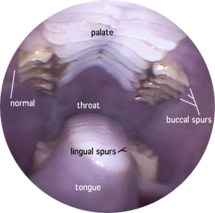
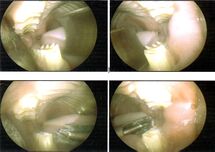
While encouraging teeth wear with chewing hay and other fibrous materials may help slow down the rate of overgrown incisors and molar spurs from developing, some rabbits are born with (or develop from physical trauma) severely misaligned teeth such that the issue will continuously reoccur throughout their lifetime and require ongoing medical procedures to keep the rabbit comfortably eating on their own.
Overgrown teeth roots
In other cases, overgrown teeth roots can be the cause of many health issues such as weepy eyes, sneezing, and anorexia. When severe, teeth roots can grow into the eyes and cheeks and even break the skin. This condition cannot usually be diagnosed with a visual check by a veterinarian and requires more advanced imaging such as radiographs and CT scans.
Overgrown teeth roots should be treated with pain management and ultimately surgical removal if appropriate. More information about rabbit teeth removal can be found in the Malocclusion article.
The following are some resources about rabbits with overgrown teeth roots:
- IMV Imaging. (2022). Case Study – The Inappetent Rabbit
- Long Beach Animal Hospital. (2019). Rabbit Teeth Conditions (Graphic)
- E. Boehmer and D. Crossley. (2009). Objective interpretation of dental disease in rabbits, guinea pigs and chinchillas [PDF]
Dental abscesses
Many kinds of trauma and dental issues like malocclusion can develop into dental abscesses.
- Dr. Honzelka. Dental (tooth) Abscesses in Rabbits
- R. Avery Bennett, DVM, MS, DACVS. (2009). Managing dental abscesses in rabbits (Proceedings)
- PetMD. (2008). Apical Abscesses in Rabbits
Feeding methods
Rabbits with dental problems often struggle to eat foods that require chewing such as hay and pellets. Because it is imperative that rabbits constantly have food moving throughout their gut, mashes of rabbit-safe foods are a good way to help rabbits voluntarily eat rather than force-feeding food such as Critical Care.
Lisa Hodgson created the following mash recipes:[5]
Carrot Crush (can be syringe fed)
- 1 large peeled tomato
- 1 10cm piece of carrot
- 1 4cm piece of broccoli
- 1 4cm piece of cauliflower
- 2 springs of parsley
- 5 mL of water
Green Dream (can be syringe fed)
- 1 small leaf kale
- 2 small leaves of pak choi (bok choy)
- 2 sprigs of coriander
- 2 sprigs of mint
- 1 4cm piece of broccoli
- 1 3cm piece of cucumber
- 15 mL of water
Banana Brunch
- 1 8cm piece of banana
- 10 Tbsp of oat bran
- 15 mL of water
Bran Bliss
- 1 8cm piece of carrot
- 3 sprigs of coriander
- 10 Tbsp of oat bran
Blend ingredients for 10 to 20 seconds or until consistency is smooth. If texture looks dry add a little more water.
Note: New foods should always be introduced gradually. These recipes are a supplement and should only be given as part of a healthy diet. Oat bran is not suitable for overweight rabbits as it may cause weight gain.
Kathy Smith noted the following experience and recipe:[5]
My intuition told me to offer her (via syringe) some of the smoothie I was making for myself every day. I now add 2-3 teaspoons of this to about 1/2 cup softened Kaytee Rainbow Exact and give to her every day:
- 1 cup of apple juice (no sugar added)
- 2-3 handfuls of fresh blueberries
- 12 large or 15 medium strawberries
- 2 small-to-medium bananas
- 12-15 ice cubes
Blend on "smoothie" setting until... smooth.
Pat Vanecek suggested this homemade Critical Care recipe:[6]
- 1/4 of a banana
- 1/8 cup regular rabbit food pellets
- 1/4 cup unflavored Pedialyte
- 1/8 cup canned pumpkin
- options: rabbit vitamins, hay (can clog syringe) , calf manna, uncooked oatmeal (not quick), molasses
Blend in blender until smooth and thin enough to syringe feed. Additional Pedialyte added will thin to a baby food paste consistency. Place syringe behind front teeth and squeeze a pea-sized portion into rabbit’s mouth. Allow to chew and swallow between bites. Feed 1 ml, 2 to 3 times per day until rabbit begins to eat normally. Keep ingredients on hand at all times. From Bunnybees.com
Extra resources
- Sarah Kolb. (2017). Rabbit Dentistry
- Vittorio Capello. (2016). Diagnostic Imaging of Dental Disease in Pet Rabbits and Rodents [PDF]
- Jennifer Hamlin. (2013). Causes, examination and treatment of dental disease in rabbits
- Susan Horton, DVM. Dental Disease (Graphic)
- Dana Krempels, Ph.D. Dental Disease in Rabbits: A Simple Overview
- MediRabbit. Common dental disorders of rabbits
- Long Beach Animal Hospital. Rabbit Teeth Problems (Graphic)
- Frank J. M. Verstraete, DrMedVet & Anna Osofsky, DVM. (2005). Dentistry in Pet Rabbits [PDF]
- A. Meredith. Rabbit Dentistry [PDF]
- Rabbit Welfare Association & Fund. Rabbit Dental Problems
Exam Overview
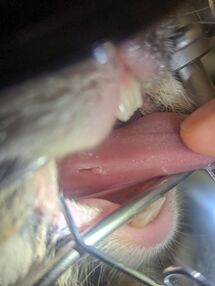
🤔 DID YOU KNOW? – Posted on FB by Trinity Veterinary Centre on May 10th, 2024
Did you know only around 40% of issues can be identified during a conscious dental examination of your rabbit? We often examine a rabbit's mouth with an otoscope to check for sharp spurs, sores or signs of discomfort but they have large tongues and lots of tissue inside the mouth reducing visibility.
To get a full picture of this we can need to give a general anaesthetic and move the tongue and buccal tissue out of the way. As you can see in this video a spur can be very well hidden and easily missed on a conscious examination.
This rabbit seemed uncomfortable around the mouth but our vet could not visualise the teeth properly conscious. An anaesthetic was administered and the spurs discovered, there was also a painful cut on the side of the tongue (picture in comments) that the sharp points had caused. These teeth were burred back to normal angle and pain relief given for the wound on the tongue.
Basic Overview
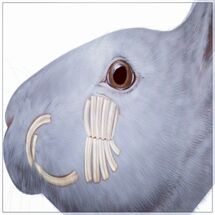
🤔 DID YOU KNOW? – Posted on FB by Bunanza Rabbit Rescue Ranch and Adoption Center on September 13th, 2020
Rabbits have a total of 28 teeth: 4 incisors (those are the big choppers up front; what you picture when you think of 'bunny teeth'). There are 2 of those on the top and 2 on the bottom. These are the teeth they use to chunk off mouthfuls of food...or to bite through phone cables!
Right behind the top incisor teeth are 2 small peg-like teeth called auxiliary incisors or (duh) 'peg teeth'. They also help with severing things, especially if it's something tough that needs more than just a quick snip.
They also have 6 upper and 4 lower premolars, then 6 molars up top and 6 more molars down below. Collectively, these 22 teeth further back in their cheeks are known as (more duh) 'cheek teeth'. Just as with our own premolars and molars, they're used to grind food, readying it to be swallowed and digested.
Unlike us, however, rabbits have teeth that never stop growing, so it's not just that they *like* to bite and chew – though they do – but it's actually a necessity for them. They MUST continually wear down their teeth or, trust us, there will be much dental badness and huge vet bills!
You can help your bunny care for their teeth by feeding the roughest cut hay they're willing to eat (1st cut takes the most biting and cutting work, 3rd cut is the softest and often suggested for old rabbits or ones who already have tooth trouble of one kind or another; 2nd cut is in between) and providing lots of tempting chew toys.
Properly maintained, all those teeth are SHARP! Every time we get a glimpse of them, we can't help thinking, "Boy, it's a really good thing they like us!"
Online support communities
The following are communities that specialize in helping owners with rabbits that need regular dental care.
- Facebook, Rabbit dental support group (Private group)
Further reading
- Bishops Stortford Veterinary Hospital. How to check your rabbit’s teeth
- Robin Rysavy, DMA in consultation with Brock Exline, DVM. (2016). Rabbit Teeth: How They Work
- Dale Kressin, DVM, FAVD, Dipl. AVDC. Anatomy of rabbit teeth
- MediRabbit. Healthy rabbit dentition
See also
References
- ↑ 1.0 1.1 Jennifer Hamlin. (2013). Causes, examination and treatment of dental disease in rabbits. Retrieved 7 Nov 2024 from https://www.theveterinarynurse.com/content/clinical/causes-examination-and-treatment-of-dental-disease-in-rabbits/
- ↑ 2.0 2.1 2.2 Veterian Key. (n.d.). Dental Disease. Retrieved from 02 Feb 2022 from https://veteriankey.com/dental-disease/
- ↑ 3.0 3.1 3.2 Varga, M. (2013). Textbook of rabbit medicine. (2nd ed.).
- ↑ Keeble, E & Meredith, A. (2006). Rabbit medicine & surgery: Self-assessment color review.
- ↑ 5.0 5.1 Moore, L. (2013). Rabbit nutrition and nutritional healing. (2nd ed.).
- ↑ Pat Vanecek. (2015). Caring for Rabbit Kits. Retrieved 13 August 2015 from http://www.bunnyrabbit.com/Newsletter/bunnyrabbitcom_articles/caringBabyKits.htm


